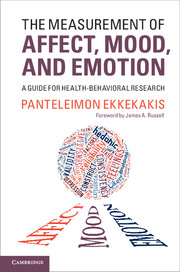Book contents
- Frontmatter
- Contents
- Figures
- Foreword
- Prologue
- 1 Documenting the breadth and depth of the problem
- 2 Untangling the terminological Gordian knot
- 3 Should affective states be considered as distinct entities or as positioned along dimensions?
- 4 Are pleasant and unpleasant states independent or polar opposites?
- 5 Selecting a measure
- 6 The old classics
- 7 Dimensional measures
- 8 Domain-specific measurement
- 9 Problems of domain specificity
- Epilogue
- References
- Index
1 - Documenting the breadth and depth of the problem
Published online by Cambridge University Press: 05 March 2013
- Frontmatter
- Contents
- Figures
- Foreword
- Prologue
- 1 Documenting the breadth and depth of the problem
- 2 Untangling the terminological Gordian knot
- 3 Should affective states be considered as distinct entities or as positioned along dimensions?
- 4 Are pleasant and unpleasant states independent or polar opposites?
- 5 Selecting a measure
- 6 The old classics
- 7 Dimensional measures
- 8 Domain-specific measurement
- 9 Problems of domain specificity
- Epilogue
- References
- Index
Summary
Measurement issues are very frequently ignored, or treated cavalierly, almost mindlessly, in research reports. Measures seem to be used because they are “there,” because someone else has used them, because nothing “better” is available. One cannot help but be amazed at the naive faith invested in what are at best crude measures by researchers who exhibit healthy skepticism, care, and sophistication with respect to other aspects of their studies.
(Pedhazur & Pedhazur Schmelkin, 1991, p. 28)A growing number of behavioral scientists across a broad range of disciplines now recognize the central role of affect, mood, and emotion in human behavior in general, and in health behavior in particular (see Figure 1.1). For example, reference to these constructs is made at an increasing rate in the literatures on eating behavior and food choices (e.g., Lutter & Nestler, 2009; Macht, 2008; Moore & O’Donohue, 2008; Stroebe, Papies, & Aarts, 2008), the causes of the obesity epidemic (e.g., Kishi & Elmquist, 2005; Rolls, 2007), the addictive effects of drugs of abuse (e.g., Baker, Piper, McCarthy, Majeskie, & Fiore, 2004; Bechara, 2005; Koob, 2008; Robinson & Berridge, 2008), the initiation and cessation of cigarette smoking (e.g., Carmody, Vieten, & Astin, 2007; Schleicher, Harris, Catley, & Nazir, 2009), the antecedents and consequences of drinking alcohol (e.g., Gilman, Ramchandani, Davis, Bjork, & Hommer, 2008; King, de Wit, McNamara, & Cao, 2011; McKinney, 2010; McKinney & Coyle, 2006), the effects of sleep and the predictors of sleep disruptions (e.g., McCrae, McNamara, Rowe, Dzierzewski, Dirk, Marsiske, & Craggs, 2008; Walker, 2009), and the effects of exercise and the reasons behind physical inactivity (Ekkekakis, Parfitt, & Petruzzello, 2011; Rhodes, Fiala, & Conner, 2009; Williams, 2008).
- Type
- Chapter
- Information
- The Measurement of Affect, Mood, and EmotionA Guide for Health-Behavioral Research, pp. 1 - 32Publisher: Cambridge University PressPrint publication year: 2013



